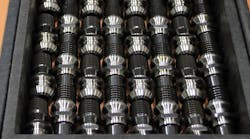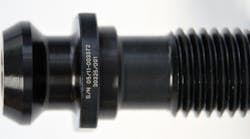By their very nature high-nickel, iron, or cobalt alloy steels (including Monel, Inconel, Incoloy, Invar, Rene and Hasteloy) are some of the most difficult materials to machine. These superalloys are designed to be difficult to cut or tear, to deliver high strength at extremely high temperatures in components often found in “hot” sections of engines and turbines, and to withstand the stresses and heat generated during machining are considerable.
In this process, the edge of the cutting tool is exposed to considerable mechanical stress, strain and heat. High compressive and shearing forces attack this edge, increasing material temperatures to the extent that that the cutting tools can begin to lose hardness. This can produce a “gummy” machining behavior, and also may cause work hardening.
According to Janos Garaczi, president of Delta Machine Company LLC., a California company that specializes in machining complex, tight-tolerance parts from titanium, nickel, stainless steel, and other exotic alloys, as well as aluminum and plastics, this is caused when chips do not break away cleanly from the workpiece.
“It can be really difficult to turn or mill this type of material because it doesn’t produce a clear shearing action. Instead it just kind of pushes the material to the side,” Garaczi explained.
“Gummy” machining is also the cause of heavy burrs in drilled holes or grooves.
“The burrs are one of the biggest problems,” Garaczi added. “Even during ‘grooving,’ if you cut the material from one side it just pushes the burr to the edge; and if you approach it from the other side, it just pushes it back. It doesn’t want to break off the material cleanly. As soon as the tool gets a bit dull it gets a lot worse, so sharp tools with the right geometry are key.”
The generally poor machinability ultimately compromises the parts’ surface integrity, he said, which is problematic because that is one of the primary causes of failure for these types of components.
Given the critical nature of the applications in which these components are used, most machined super-alloy parts therefore must undergo a surface finishing operation to remove work-hardened layers and any heavy burrs. Doing so has additional benefits, including reducing the risk of oxidation and stress corrosion cracking (SCC).
Although traditionally this surface-finishing has been achieved by an expensive, messy, and time-consuming grinding process, new flexible hones are simplifying the task by incorporating one of the toughest, hardest materials on the planet – Cubic Boron Nitride (CBN).
CBN combines the highest hardness with excellent toughness to achieve optimal surface finish. Flexible hones made of this type of material can be mounted on CNC equipment for automated operations or used in the field with handheld power tools to wear away work-hardened surfaces without inducing additional thermal distortion.
Super-alloys — High-nickel alloy steels are prized in these markets because of their excellent resistance to corrosion and heat, with strength, toughness, metallurgical stability, and weldability. Such super-alloys are a great choice for applications that require reliability and performance with elevated standards for chemical resistance and mechanical strength. Their material properties include low expansion at severe temperatures and creep resistance under high stress.
As such, super-alloys are widely used as material for the hottest parts of complex equipment, including nuclear-power plant components, high-performance automotive parts, and jet-engine turbines. Nickel, iron, and cobalt alloys also are used widely for aerospace components, medical devices, petrochemical and refining applications, and thermal processing.
According to Garaczi, with the right cutting tools milling nickel alloys and stainless steels still is limited as to the surface finish that can be achieved to, at best, 32 Ra. With turning, 16 Ra is possible, but most of the time it requires a grinding or polishing step.
“Grinding is a very common process in these cases, but it is very time-consuming and very expensive to have to grind a part. In some cases, it could take longer than the initial machining.”
As such, Garaczi said that Delta Machine often sends out parts to a subcontracting shop for grinding or polishing, opting not to perform this type of operation in house.
Flexible Hones — For many machine shops, a flexible hone is a much more efficient tool for overall surface finishing. Often such a low-cost tool is used for sophisticated surfacing, de-burring, edge-blending, and cleaning. Until recently, however, flexible hones with CBN abrasive were available only by special order. Now, the company that invented the Flex-Hone® tool, Brush Research Manufacturing, offers CBN surface-finishing solutions as part of its standard product line.
Somewhat resembling a spinning bottlebrush, the Flex-Hone tool is characterized by abrasive globules that are permanently mounted to flexible filaments, which are attached to a center shaft. With its low-pressure, low-temperature abrading process, BRM’s CBN Flex-Hone tools can remove work-hardened layers and deburr parts without disturbing the underlying metallurgical structure.
Standard CBN Flex-Hone tools are offered in sizes ranging from 4 to 20 mm, in three different mesh sizes: 170/200, 800, and 2,500. Larger-sized products from 22 to 38 mm, and additional mesh sizes, are available by special order.
Garaczi said he can see the advantage of being able to install a flexible hone into CNC equipment to automate the process and speed up the time when finishing super-alloys and stainless steels. He is in a unique position, having started with the Delta Machine as a machinist and eventually working his way to president and owner. As such, he remains responsible for much of the programming, set-ups and also purchasing.
When making decisions about what tools to purchase he indicated that often the choices are made on a project-by-project basis. However, if the tool can reduce cycle times versus its cost, it is an easy decision.
“There are definitely scenarios where it would be good to be able to perform surface finishing of this type of material on CNCs,” Garaczi said. “It would really save a lot of time and extra processing cost.”
Jeff Elliott is a Torrance, Calif.-based technical writer. His recent contributions to AmericanMachinist.com include Planar Honing Offers a New Angle for Surface Finishing and Could a Less-than-$100 Part Save U.S. Manufacturing? .








